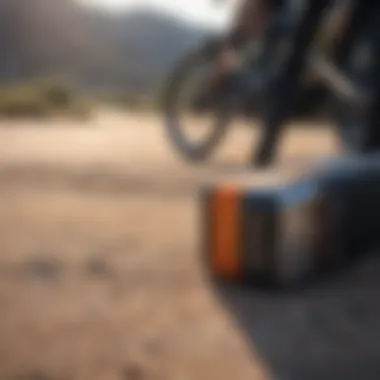Understanding Efoil Battery Life: Key Insights


Intro
The battery life of efoils significantly affects the user experience and performance in this thrilling water sport. Understanding the various factors that contribute to battery capacity and efficiency allows enthusiasts to make informed choices and optimize their time on the water. This article delves into the types of batteries commonly used for efoils, effective charging practices, and essential maintenance tips to extend battery life. As efoil technology advances, keeping abreast of new trends can further enhance performance.
Techniques and Tips
Skill Development
For those venturing into efoiling, cultivating the necessary skills is paramount. Mastering balance and control on the board directly influences how you use the battery. As riders improve their technique and efficiency, they can enjoy longer rides. Regular practice not only builds confidence but also helps mitigate battery drain through more controlled maneuvers.
Practical Techniques
- Optimize Speed: Riding at a moderate speed can significantly enhance battery life. High speeds consume more power, thus shortening your ride duration. Avoid full-throttle starts and practice gradual acceleration.
- Reduce Weight: Carrying unnecessary gear adds to the load, which in turn strains the battery. Pack only what you need and opt for lighter equipment to conserve energy.
- Stay Aware of Conditions: Water conditions impact riding efficiency. Rough waters require more energy, whereas calm waters allow for better glide efficiency. Consider timing your rides when conditions are favorable for battery conservation.
Common Mistakes to Avoid
- Neglecting Battery Maintenance: Failing to care for your battery can lead to reduced lifespan. Ensure terminals are clean and connections are secure.
- Ignoring Temperature Effects: Batteries perform poorly in extreme temperatures. Avoid exposing batteries to direct sunlight and extreme cold during usage and storage.
- Improper Charging Practices: Overcharging can damage batteries. Always follow the manufacturer’s guidelines regarding charging times and processes.
Gear and Equipment
Essential Gear for Beginners
Investing in the right gear is crucial for an enjoyable efoiling experience. New riders should consider:
- Quality Efoil Setup: Look for brands like Lift Foils or Fliteboard, which offer reliable performance and user-friendly designs.
- Safety Equipment: Personal flotation devices and helmets should be a priority to ensure safety while learning.
Latest Innovations and Trends
The efoil industry is continuously evolving, and recent trends focus on improving battery technology. New materials like lithium-sulfur batteries promise better energy density and longer life cycles. Brands are also experimenting with battery management systems that monitor the health and efficiency of the battery throughout its usage.
Reviews and Comparisons
When choosing batteries for efoils, it’s helpful to look at reviews and performance comparisons. User feedback on products like the Samsung 18650 or the LG M50 can guide you in selecting reliable options with good longevity and performance metrics. Consider reading detailed analyses on forums like Reddit for user experiences.
Safety Measures
Essential Safety Gear
Safety in efoiling is non-negotiable. Here’s a list of mandatory equipment:
- Buoyancy Aid: Helps keep you afloat in case of an accident.
- Helmet: Protects against head injuries during falls.
- Wetsuit: Provides thermal protection and reduces the impact of falls.
Best Practices for Safe Participation
To ensure a safe efoiling experience, follow these best practices:
- Know your limits: Start in calm waters and avoid crowded areas.
- Always inspect equipment: Before each ride, check the condition of the board, battery, and connections for any signs of wear.
Injury Prevention and Management
Avoiding injuries while efoiling involves:
- Warm-Up Exercises: Stretching before rides can prevent muscle strains.
- Immediate Response to Accidents: In case of falls, use the appropriate techniques to minimize injury. Landing correctly can significantly reduce impact.


"Understanding battery management and maintenance is essential for maximizing your time on the water. "
End
Prelude to Efoil Technology
Efoil technology represents a significant leap in the realm of water sports. It integrates cutting-edge engineering with principles of hydrodynamics to offer a unique riding experience. Riders can glide above water, thanks to a hydrofoil attached to a surfboard-like platform. Understanding efoil technology is crucial as it impacts performance, safety, and user enjoyment. This introduction lays the groundwork for comprehending how battery life affects efoil operations.
One key aspect of efoiling is its reliance on battery systems to power the electric motor. The performance of efoils largely depends on the battery's capacity and health. Batteries directly influence ride time and overall efficiency, making knowledge of their function essential. An informed user can make better choices regarding equipment and riding techniques, ultimately prolonging battery life. This understanding not only enhances the efoiling experience but also contributes to environmental conservation by promoting efficient energy use.
Ongoing developments in efoil technology are largely driven by advancements in battery science. Thus, recognizing the trajectory of these innovations can offer insights into future improvements in battery efficiency and performance. This connection is critical for thrill-seekers who seek out the latest in extreme sports technology.
What Are Efoils?
Efoils, or electric hydrofoils, are a blend of surfing and flying over water. They comprise a conventional board equipped with a battery-powered electric motor and a hydrofoil underneath. The hydrofoil generates lift as the board moves, allowing it to rise above water. This phenomenon enables riders to carve through waves with minimal drag, creating a new sensation of gliding. Efoils appeal to a variety of individuals, from dedicated surfers to newcomers keen on trying new activities.
The core components of an efoil include the board, the hydrofoil, a propulsion system, and, of course, a battery. The interaction between these components determines how smoothly an efoil operates. Variations in design and technology can lead to performance differences, influencing ride quality and user experience.
The Evolution of Efoil Designs
Efoils have undergone substantial transformation since their inception. Early models were rudimentary, often limited in battery life and power. However, continuous advancements in design and technology have resulted in more efficient efoils. Modern iterations boast enhanced battery capacities, superior hydrodynamics, and streamlined control systems.
Key milestones in efoil development include:
- Improved Battery Technology: With innovations in lithium-ion and lithium polymer batteries, today's efoils can achieve longer ride times and faster charging. These upgrades directly enhance user enjoyment and convenience.
- Hydrodynamics: Manufacturers have developed more refined foils, allowing for better lift and reduced drag. These designs lead to improved stability and maneuverability during rides.
- User Interface: The integration of wireless remote controls and smart systems empower users to monitor battery levels and control speed with greater precision.
The evolution of efoil technology reflects ongoing research and development efforts aimed at creating safer, more efficient, and ultimately more enjoyable experiences for riders. Understanding this progression is essential for enthusiasts eager to stay informed about the latest trends and innovations in the sport.
Battery Basics: Understanding the Heart of Efoils
Battery technology is fundamental to the performance and efficiency of efoils. Knowing how batteries work helps users to maximize their time on the water and improve the overall riding experience. As efoils continue to gain popularity, understanding battery basics becomes crucial for enthusiasts who seek optimal performance. More than just a power source, batteries can dictate how long and how fast one can ride.
Types of Batteries Used in Efoils
Various battery types are employed in efoils, each with unique characteristics that affect performance and usability.
Lithium-ion Batteries
Lithium-ion batteries are prevalent in the efoil market due to their favorable energy-to-weight ratio. These batteries allow for longer runtimes and lighter builds, which is vital for maneuvers and ease of control on the water. Their key characteristic is their ability to maintain a high voltage for longer periods, which results in sustained power output throughout the ride.
One unique feature of lithium-ion batteries is their fast charging ability. This is beneficial for users who may want to quickly recharge between sessions. However, lithium-ion batteries also have some drawbacks. They can be relatively expensive and may require more careful handling to prevent damage. Moreover, they can experience reduced performance in extreme temperatures, which might limit usability in very hot or cold weather.
Lithium Polymer Batteries
Lithium polymer batteries are another option for efoils. They are often preferred for their flexibility and shape, allowing manufacturers to design batteries that fit specific efoil shapes. The key characteristic of lithium polymer batteries is their lightweight nature, making them an attractive choice for performance enthusiasts.
One notable unique feature is their ability to be produced in various configurations, which can optimize space in the efoil’s design. The advantages of lithium polymer batteries include lower weight and the ability to discharge quickly. However, this battery type often has a lower lifespan compared to lithium-ion batteries, and they may require more meticulous care during charging to avoid swelling or damage.
Battery Specifications and Ratings
Understanding battery specifications is essential. Common metrics include amp-hour (Ah) ratings, voltage, and watt-hours (Wh).
- Amp-hours (Ah) indicate the amount of energy a battery can deliver over time. A higher Ah means a longer ride.
- Voltage affects the power output and efficiency; typically, a higher voltage is beneficial for more power.
- Watt-hours (Wh) combine both voltage and amp-hours to provide a clearer idea of total energy capacity.
These specifications inform choices and can significantly affect riding experience. Selecting the right battery with suitable ratings ensures optimal performance and longevity for efoils. This understanding can greatly enhance the thrill-seeking experience while managing expectations regarding battery life.


Factors Affecting Efoil Battery Life
Battery life in efoils does not depend solely on the battery itself. It is influenced by a multitude of factors, each playing a significant role. Understanding these factors helps users optimize performance and enhance their experience on the water. The interplay of rider behavior, weight, and environmental conditions can dramatically affect how long an efoil operates before needing a recharge. By comprehending these elements, enthusiasts can adapt their approach to maximize battery efficiency.
Riding Style and Its Impact
The way a rider maneuvers the efoil can have a profound effect on battery consumption. Aggressive riding styles, such as rapid acceleration and sharp turns, demand more energy from the battery compared to smooth, steady cruising. When a rider frequently shifts weight or takes on a high-speed approach, the battery must exert more power to maintain balance and speed. Riders looking to extend their ride time should focus on mastering a calm and fluid technique.
Weight Considerations
Weight is another critical factor that influences battery life. The combined weight of the rider and any additional gear directly impacts performance. Heavier loads require more energy to lift off the water and maintain speed. It is advisable for users to find an optimal weight range that allows for agile movement without overtaxing the battery. Reducing unnecessary equipment and opting for lightweight gear can enhance battery life significantly.
Environmental Conditions
Environmental factors, particularly water temperature and wind conditions, also dictate battery efficiency. These elements can either hinder or help a rider's performance depending on the circumstances present on any given day. Understanding how each specific condition interacts with battery performance is essential for effective management.
Water Temperature
Water temperature plays a significant role in battery performance. Warmer waters often increase efficiency, promoting effective battery usage. Cold water can lead to reduced battery capabilities, as the chemical reactions occurring within the battery slow down. As such, riders should monitor water temperatures and adapt their expectations accordingly.
"Water temperature can diminish battery life significantly, thus it is crucial to know the conditions before going out."
Advantages of riding in milder waters include extended sessions and better stability. In colder waters, riders might experience a faster depletion of power, undermining the overall enjoyment of the experience.
Wind Conditions
Wind conditions pose another challenge affecting battery life. Strong headwinds require riders to exert more energy to cut through opposition, accelerating the drain on the battery. Conversely, tailwinds can contribute positively by offering a boost, allowing riders to enjoy extended periods of riding without straining the battery.
Overall, becoming aware of wind conditions can help riders make informed choices about when to hit the water and how to adjust their riding style accordingly. Riders should closely observe wind patterns to capitalize on favorable conditions.
Understanding these factors is essential for efoil enthusiasts looking to optimize battery life and enhance their riding experience. By adjusting riding styles, managing weight effectively, and adapting to environmental conditions, users can prolong battery life significantly.
Best Practices for Maximizing Battery Life
Maximizing the battery life of an efoil is essential for ensuring not just a longer ride but also a more enjoyable experience on the water. Understanding the intricacies of battery management is vital for thrill-seekers and adventure lovers who rely on their efoils for extended periods of surfing, racing, or simply cruising through the waves. This section delves into two significant best practices: proper charging techniques and regular maintenance and care. These aspects can greatly extend the life of your efoil’s battery, enhancing performance and overall enjoyment.
Proper Charging Techniques
Charging techniques have a substantial impact on the longevity of efoil batteries. It is important to adopt correct methods to ensure that batteries are properly charged without causing damage. Here are some fundamental practices:
- Use the Manufacturer's Charger: Always use the charger provided by the manufacturer. This charger is designed specifically for your battery type, ensuring optimal performance.
- Avoid Overcharging: Keeping your battery connected to the charger long after it has reached full capacity can lead to overheating and potential damage. Most modern chargers come with automatic cut-off features, but it’s good to keep an eye on the charging status.
- Charge at Room Temperature: Charging batteries at extreme temperatures can affect their lifespan. Ideally, maintain a charging environment of 20 to 25 degrees Celsius (68 to 77 degrees Fahrenheit).
- Charge Regularly: Don't let your battery drop too low before recharging it. Ideally, recharge the battery once it reaches around 20% capacity.
- Balance Charging: For those using lithium polymer batteries, consider balance charging. This process ensures all cells within the battery are charged equally, which enhances safety and performance.
Adhering to these charging techniques will help maintain battery efficiency and significantly extend its life, allowing more time on the water.
Regular Maintenance and Care
Just like any high-performance device, an efoil battery requires regular attention. Neglecting maintenance can lead to premature degradation. Here are the recommended practices:
- Inspect Battery Health: Regularly check the battery for any physical damage or signs of swelling. Swollen batteries should be handled with care and disposed of properly.
- Clean After Use: Saltwater and dirt can damage the components of your efoil. After use, rinse the battery and connections with fresh water and wipe down everything with a soft cloth.
- Store Properly: When not in use, store your efoil battery in a cool, dry place and charge it to about 50% capacity. This state is ideal for long-term storage as it minimizes stress on the cells.
- Monitor Cycle Count: Keep track of the number of charge cycles your battery has experienced. This information can be critical for knowing when to expect performance loss and making informed decisions about replacements.
Regular maintenance is key to extending cycle life. A well-cared-for battery not only performs better but also lasts longer.
Understanding Battery Degradation
Battery degradation is a critical aspect when discussing the performance and longevity of efoil batteries. Understanding this concept is essential for anyone involved with efoils, whether they are seasoned riders or new enthusiasts.
The importance of recognizing battery degradation lies in its direct impact on efoil performance. A battery that deteriorates can lead to reduced power, shorter ride times, and ultimately, a less enjoyable experience on the water. With the right knowledge, individuals can make informed decisions to prolong battery life and maintain optimal functioning.


Several factors contribute to battery degradation. These include the number of charge cycles a battery undergoes, exposure to extreme temperatures, and overall maintenance practices. Battery aging is not just a question of time; it is about the operational conditions and usage patterns. Hence, being proactive about battery care can significantly delay the onset of degradation.
Signs of Battery Aging
Identifying the signs of battery aging is crucial for efoil users. The performance of efoil batteries can decline noticeably as they age, which affects the entire riding experience. Here are some common indicators of battery aging:
- Reduced Capacity: One of the first signs is a decreased capacity to hold a charge. If a battery that used to last for 2 hours on a full charge now only lasts for 1 hour, degradation is likely.
- Increased Charge Time: Over time, batteries may take longer to charge, which is another signal of aging. If the charging process stretches beyond the usual time, it may be time to assess the battery's condition.
- Heating Issues: An aging battery often heats up excessively during use or charging. Overheating can indicate problematic performance and potentially pose safety risks.
- Swelling or Physical Changes: A battery that is visibly swollen or deformed has likely reached a critical point of degradation and requires immediate attention.
Recognizing these signs early on can help avoid catastrophic battery failures.
How to Extend Battery Life
To enhance the lifespan of efoil batteries, following certain practices can yield significant benefits. Here are some straightforward methods to maximize battery life:
- Regular Charging Practices: Avoid letting the battery discharge completely before recharging. Keeping the battery charge between 20% and 80% can optimize its health.
- Temperature Management: Store and use batteries at moderate temperatures. Extreme cold or heat can damage the composition of the battery and hasten degradation.
- Proper Maintenance: Cleaning battery terminals and ensuring connections are secure contributes to their overall performance. Any dust or corrosion can impede functionality over time.
- Usage Tracking: Keeping a log of usage patterns and battery performance can assist in recognizing when it is time to replace a battery.
- Quality Chargers: Always use chargers recommended by the manufacturer. Off-brand or substandard chargers can deliver inconsistent power, negatively impacting battery life.
- Ideal temperature range for storage is generally between 15°C and 30°C.
By understanding battery degradation and implementing these strategies, efoil enthusiasts can gain better control over the battery’s life cycle, ensuring many enjoyable moments on the water.
Technological Innovations in Efoil Batteries
In the ever-evolving realm of efoils, the significance of technological innovations in battery systems cannot be overstated. As enthusiasts seek longer rides and enhanced performance, the quest for more efficient battery technologies becomes paramount. The transition from traditional energy sources to more advanced systems reflects a broader trend in extreme sports, where precision and durability are essential.
Emerging Battery Technologies
The development of new battery technologies plays a vital role in optimizing the performance of efoils. One notable advancement is the use of solid-state batteries. These batteries offer better energy density than conventional lithium-ion systems, resulting in extended riding time per charge. Furthermore, solid-state batteries are inherently safer, with a reduced risk of fires and leaks, making them more reliable for extreme water sports. Another promising technology involves the application of graphene, a material known for its excellent conductivity and strength. When integrated into battery designs, graphene can increase charge rates and enhance overall energy storage capacity.
While these innovations are exciting, they come with considerations. Cost remains a significant factor, as emerging technologies often require substantial investment. Therefore, while the benefits are clear, practical accessibility may limit widespread adoption in the short term.
Future Trends in Efoil Technology
Integration with Smart Systems
The integration of smart systems into efoil batteries represents a transformative step in the sport. This technology allows riders to monitor battery usage in real-time through connected devices. With features such as battery health status, usage analytics, and performance monitoring, users can make informed decisions during their rides. The key characteristic of this integration is its ability to provide data-driven insights, enhancing the overall efoiling experience.
This smart technology not only informs riders but also enables them to adapt their style in order to maximize battery life. A unique aspect is the potential for customizable presets, which can adjust the performance based on rider preference or environmental conditions. However, reliance on technology can lead to concerns about potential malfunctions, which must be addressed through effective user training and support.
Remote Monitoring Capabilities
Remote monitoring capabilities are another significant innovation in efoil battery technology. This feature allows riders to track their battery's performance from a distance, offering peace of mind and safety during adventures on the water. The key characteristic of remote monitoring is its ability to alert users to critical changes in battery status, such as low charge levels or anomalies in performance. This proactive approach helps prevent unforeseen issues, ensuring a more enjoyable and safer riding experience.
A unique feature of these capabilities is the compatibility with mobile applications, allowing for seamless integration into the rider's daily life. The advantages of remote monitoring are substantial, especially for those who venture into isolated areas. However, one disadvantage can be the dependence on mobile connectivity, which may not always be reliable in remote settings.
Technological innovations in efoil batteries are crucial for the future of the sport. By exploring emerging technologies and adapting to new trends, the efoil community can look forward to safer, more efficient, and exhilarating rides.
Culmination: Navigating Efoil Battery Life
In this article, we have dissected the multifaceted realm of efoil battery life. Understanding the nuances of battery technology is crucial for both avid enthusiasts and casual users alike. The performance of an efoil largely depends on the battery's condition, type, and the environmental factors at play. Knowledge gained from this exploration helps optimize usage time, thereby enhancing the overall experience on the water.
Synthesizing Insights
Several key factors contribute to battery life in efoils. First, the choice of battery type significantly impacts performance. Lithium-ion and lithium polymer batteries present distinct advantages and disadvantages, influencing the duration of rides and charging practices. Next, rider behavior plays a vital role. Aggressive riding or poor weight distribution can lead to reduced battery efficiency. It is also essential to regularly maintain the battery through adequate charging and care.
Furthermore, external factors, such as water temperature and wind conditions, affect battery performance. Notably, warmer water can enhance battery efficiency, whereas cold conditions can hinder it. Riding style must also adapt based on these variables.
By synthesizing these insights, we can develop strategies to extend battery life. This involves not only adopting proper maintenance techniques but also adjusting riding styles to suit environmental conditions.
Final Thoughts on Battery Usage
Every efoil enthusiast can derive immense value from this knowledge. Whether for leisurely rides or adrenaline-fueled adventures, mastering the intricacies of battery life ensures a gratifying experience on every outing. Take time to learn, adapt, and implement best practices in battery care. In doing so, the journey on the water transforms into a lasting adventure.







